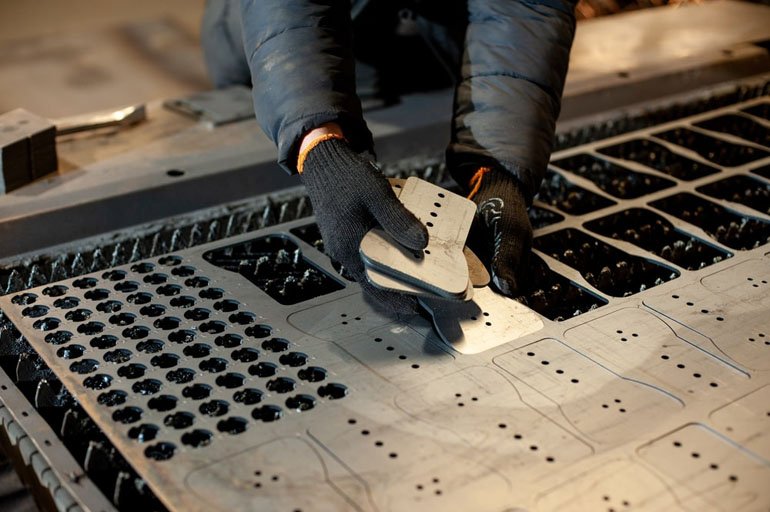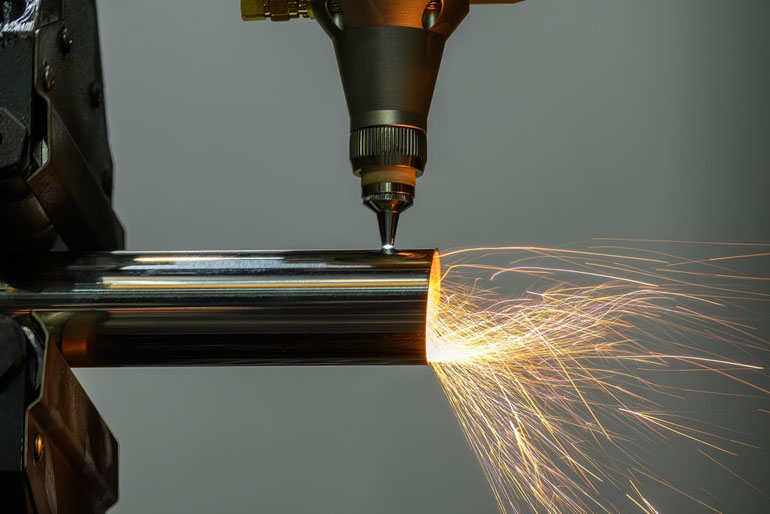Laser cutting is one of the most advanced methods of material processing. Cutting is performed using a concentrated laser beam, which enables precise cutting of even the most complex shapes. This technology allows for cutting both metals and non-metallic materials. Over the years, this technology has significantly evolved, and now dominates in many branches of industry, including automotive, aviation, electronics, and materials engineering. Laser cutters enable fast and clean cutting without the need for additional processing, making them not only more efficient but also economical in the long run.
Evolution of laser cutting technology
Traditional laser technologies, such as CO₂ lasers, plasma, and YAG, have dominated the market for years, but now they are increasingly being replaced by modern fiber lasers. The main differences between these technologies include:
-
CO₂ lasers - primarily used for cutting non-metallic materials and some metals, require a complex mirror system, high operating costs, and greater energy consumption.
-
plasma lasers - mainly used for cutting thick materials in heavy industry, require high energy demand and post-processing of elements.
-
YAG lasers - used in industry for precision applications, however, their efficiency is lower than in the case of fiber lasers.
-
fiber lasers - characterized by higher energy efficiency, versatility, precision and speed of the processing process, and lower operating costs.
Fiber laser is currently the preferred option in many industrial applications because it offers fast and precise cutting, lower operating costs, and greater durability.
Mechanism of the laser cutting process
Laser cutting is a complex thermal process in which the laser beam heats the material to the melting, vaporization, or combustion temperature. A key element is the use of an appropriate assist gas, which supports the material removal process and affects the quality of the edge. Depending on the cutting technique, the process can utilize various physical phenomena.
Physical basics of laser cutting
The laser cutting process involves delivering a high-energy laser beam to the material, which causes it to heat, melt, and in some cases, also vaporize or burn. A key role here is played by the absorption of energy by the surface of the cut element. The absorption coefficient of laser radiation depends on the type of material, the laser wavelength, and the angle of incidence of the beam.
In the case of metals such as aluminum or copper, which are characterized by a high reflection coefficient, it is necessary to use higher laser power to effectively start the cutting process. On the other hand, carbon and stainless steels are characterized by better absorption of laser energy, which facilitates processing.

Three basic laser cutting techniques
Depending on the laser parameters, type of material, and expected effects, three main laser cutting techniques are used. Each differs in its mechanism of action and is applied in specific industrial conditions.
-
Fusion cutting - involves melting the metal in the area of the cutting gap, and then removing the liquid metal by a stream of assist gas, e.g., nitrogen or argon. This process minimizes the oxidation of the cut element's edges, ensuring high surface quality.
-
Vaporization cutting - uses the intense energy of the laser beam to instantly vaporize the material. The gases formed as a result of this process are removed from the cutting gap by a stream of cutting gas.
-
Oxygen cutting (exothermic) - in this case, oxygen is used as an assist gas, which enters into an exothermic reaction with the metal, providing additional thermal energy and accelerating the cutting process. This method is particularly effective for cutting carbon steel.
What materials can be cut with a laser?
Laser cutting finds application in processing a wide range of materials, both metallic and non-metallic. With its high precision and repeatability, this process enables cutting of materials such as:
-
steel sheets - both carbon and stainless steel, where the laser provides smooth edges without the need for additional processing.
Check out: Sheet metal cutter FALCON
-
aluminum and its alloys - despite the high reflection coefficient, appropriately selected parameters allow for precise laser cutting of aluminum.
-
brass and copper - fiber lasers enable cutting of highly reflective materials.
-
plastics - such as acrylic, polycarbonate, or polyethylene, which can be processed without the risk of deformation.
-
wood and paper - laser allows for extremely precise cutting of cardboard, plywood, and other organic materials.
Thanks to the application of laser technology, it is possible to cut both thin foils and thick metal sheets. Modern laser cutters are particularly effective in processing sheets, profiles, and tubes. Process automation and advanced CNC control systems allow for fast and precise cutting of even the most complex shapes.
Check out: Tube and profile cutter FALCON
Laser cutting of tubes and profiles ensures exceptional edge quality and the ability to work with a constant level of precision. That is why it is a solution chosen by industries requiring the highest quality and repeatability of production.

Plasma cutting - an alternative to laser cutting?
Plasma cutting is another popular method of metal processing, using ionized gas at a very high temperature to melt and remove material. Compared to laser cutting, this technology offers the possibility of cutting thicker materials at relatively lower investment costs. This process is particularly effective for electrically conductive metals, which is why it is popular in heavy and structural industries.
Despite its advantages, plasma cutting also has significant limitations. The edge quality is lower than in the case of laser cutting, therefore it often requires additional processing. The process also generates a larger heat-affected zone, which can lead to deformation of the processed material. Additionally, the consumption of gas and electrodes in plasma cutting is much higher, which significantly increases operating costs in the long term. Although plasma may be a more cost-effective choice for cutting thick sheets, laser technology remains irreplaceable wherever precision, repeatability, and minimization of material losses are crucial.
Key technical parameters of laser cutting
To achieve optimal results of the processing process and fully utilize the laser technique, several important parameters should be considered. Appropriate settings allow for laser cutting of materials such as stainless steel, aluminum, or copper while maintaining high precision and high cutting speed. Laser cutting allows for processing various materials with similar dimensional parameters, while ensuring process repeatability. Thanks to this, it is possible to effectively cut both thin sheets and thicker elements without losing edge quality. Here are important laser cutting parameters:
-
laser power - determines the ability to cut materials of various thicknesses. Higher power enables faster and more efficient laser cutting of thick metal sheets.
-
laser wavelength - affects the absorption of energy by a given material, which translates into the effectiveness of the process. In the case of stainless steel and other highly reflective materials, an appropriately selected wavelength improves the quality of processing.
-
cutting speed - depends on the laser power, thickness, and type of material. Proper configuration ensures high processing speed, minimizing process implementation time.
-
type of assist gas - the choice of appropriate gas (e.g., nitrogen, argon, oxygen) affects the quality of the cutting edge and the effectiveness of the process. In the case of stainless steel, nitrogen is often used to prevent edge oxidation.
-
laser focus diameter - the smaller it is, the more precise the cutting and the narrower the cutting gap. This is crucial for complex patterns with high accuracy.
-
laser operation mode - can be continuous or pulsed, which is important for precise processing operations.
Advantages of laser cutting
Laser cutting offers many benefits compared to traditional processing methods:
-
high precision - enables cutting complex shapes with minimal error.
-
smooth edges - no need for further mechanical processing.
-
high cutting speed - reduction of processing time compared to conventional methods.
-
no tool wear - the laser does not require contact with the material, therefore it eliminates mechanical wear.
-
waste minimization - optimal use of material thanks to precise cutting.
Applications of laser cutting
Precise and fast cutting technique enables the production of both large structural elements and complex details with microscopic dimensions. Thanks to the possibilities of adjusting laser parameters to different materials, laser cutting is indispensable in many industries:
-
automotive - cutting car bodies, engine components, vehicle interior elements.
-
aviation and space - precision processing of light alloys and composite materials.
-
electronics - micro-processing of electronic components, cutting thin metal foils.
-
construction industry - production of structural and machine elements.
-
advertising and design - personalized decorative elements, cutting in wood, plexiglass, or metal.
Due to its versatility and precision, laser cutting is becoming an indispensable tool in industry, enabling the implementation of even the most complex projects with unrivaled quality and repeatability.
Laser engraving and marking
Besides cutting, laser technology also enables engraving and marking of materials. Thanks to high precision and a non-contact process, laser engraving finds applications in industrial production, product identification, and product personalization. The laser can apply permanent markings on metals or plastics, as well as glass or wood. This is extremely useful in industries requiring serial or decorative marking.
How much does laser cutting cost? Are laser cutters expensive?
The costs of laser cutting depend on many factors, such as the thickness and type of material, cutting length, and the complexity of the pattern. The pricing of the service may vary depending on the technology used for processing, laser power, and the shielding gas used.
These costs should also be considered in the context of investment in laser cutters. Professional machines for metal processing (cutting sheets or profiles and tubes) are technologically advanced devices, whose prices can range from several hundred thousand to several million zlotys, depending on the laser power, level of automation, and additional functions. A detailed comparison of available laser cutters can be found in our: Guide to laser cutters.
Also read: What to pay attention to when buying a laser cutter?
Laser cutting - the future of precise material processing
Laser cutting is an advanced technology that has revolutionized the material processing industry, especially metal processing. Unlike classical mechanical processing, which uses cutting tools and chip processing, the laser allows for non-contact cutting, eliminating the need for mechanical forces and reducing tool wear. This makes it possible to obtain extremely smooth edges without burrs and the need for additional surface finishing.
The application of lasers in industry covers a wide range of sectors, from automotive and aviation to electronics and the production of precision components. The choice of appropriate technique and process parameters allows for excellent results, and the dynamic development of laser technology leads to further improvement in efficiency and quality of processing. Modern laser systems are becoming increasingly energy-efficient and productive, which only strengthens their position in industry. Over the years, we can expect even greater automation and integration of lasers with intelligent control systems, which will allow for further optimization of production processes.
Bibliography:
- Andrzej Klimpel, Theoretical basis of laser cutting of metals, "Welding Review", 6/2012, online access [31.01.2025] https://www.researchgate.net/publication/323326207_Podstawy_teoretyczne_ciecia_laserowego_metali
- Andrzej Klimpel, Welding, bonding and cutting of metals: technologies, WNT Publishing House, Warsaw 1999.
